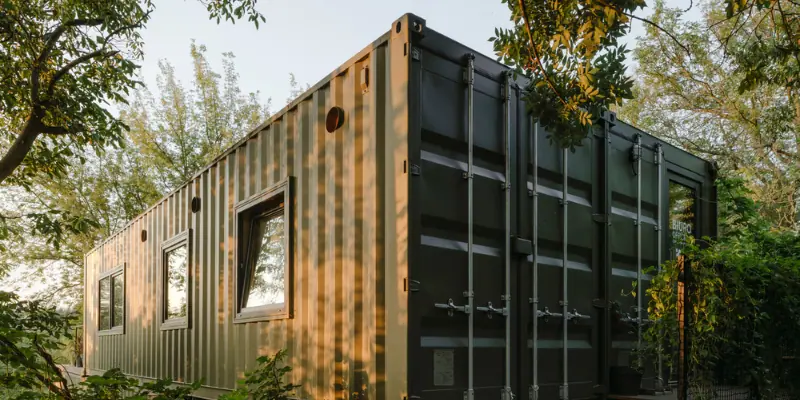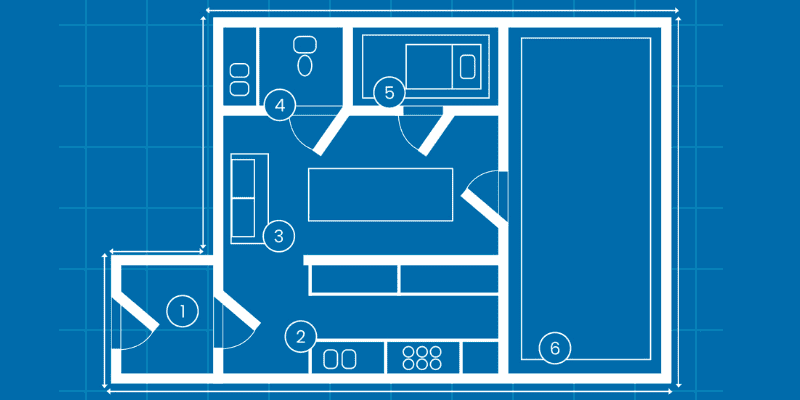Living in a traditional home may be suitable for some people due to various conditions. If you are looking for affordable and sustainable living options building a shipping container home is the best solution out here. They provide flexibility and various unique options to style the living spaces to fit your needs.
However, starting on this journey can be overwhelming, especially if you are a beginner. This complete guide will walk you through 10 essential tips, ensuring a successful and smooth experience when building your container home.

1. Start with a Clear Plan
Having a clear plan before starting with anything is the best step to take. Here are the things to start with:
- Choose Size and Layout: Decide how many shipping containers you’ll need, keeping in mind the size of your home, the layout, and your budget. Common container sizes are 20 and 40 feet long.
- Create a Floor Plan: Sketch out your desired floor plan, including how the containers will be arranged (side by side, stacked, etc.). You can get inspiration from existing container homes or consult an architect.

- Budgeting: Outline your budget, considering costs for containers, foundation, insulation, permits, and other construction needs. Planning for unexpected costs is also important.
- Purchasing a Container: Having a reliable provider from whom you can have your customized shipping container as per the space available for you to built home is the most important step.
Finding a portable shipping container contractor can be a time consuming task, explore used shipping containers of Asprefab to check if they fit your needs.
Taking these steps will give you a roadmap, allowing you to tackle the project with confidence.
2. Check Local Building Regulations
Every area has specific building codes, zoning laws, and regulations for alternative home structures like container homes. To avoid costly legal issues:
- Research Permits: Check if your local government allows container homes and what permits you need. This may include permits for land use, plumbing, electricity, and environmental regulations.
- Talk to Local Authorities: Some regions have restrictions on the height or location of shipping container homes. It’s essential to speak to city officials to ensure compliance with local laws.
- Permit Costs: Factor in the costs of obtaining necessary permits into your overall budget, as these can add up quickly.
By getting the legalities out of the way early, you avoid delays and costly penalties.
3. Choose the Right Used Shipping Containers
Not all shipping containers are the same, so it’s essential to choose wisely. Consider these points:
- One-Trip Containers: Opt for one-trip containers whenever possible, as these have only been used once and are usually in excellent condition.
- Used Containers: Alternatively, if you’re on a tight budget, used containers can be a good option. Make sure to inspect them for damage, rust, or contamination. If you’re exploring this option, choosing used containers can significantly cut costs while still providing a solid structure. Learn more about this by visiting this guide on how used shipping containers can help you save.
- Size and Condition: Ensure that the containers you choose are of the right size and in good structural condition for your home’s design.
4. Prepare the Foundation of Container Home
Even though shipping containers are sturdy, a strong and stable foundation is essential. Here are common foundation types:
- Concrete Slab Foundation: A solid, level base for your container home that evenly distributes weight.
- Pier Foundation: This uses concrete blocks or piers to raise the home above ground level, which is useful for areas prone to flooding.
- Strip Foundation: Less expensive, this foundation supports the container at its corners and along its sides.
Choose the foundation that best suits your terrain and budget, ensuring that it is level and strong enough to support your containers.
5. Focus on Insulation
Shipping containers are made of steel, which means they can become very hot in the summer and cold in the winter. Proper insulation is vital for maintaining a comfortable living environment. Consider the following insulation options:
- Spray Foam Insulation: Provides an airtight seal, preventing moisture from entering your home.
- Rigid Board Insulation: A cost-effective option that’s easy to install and provides good thermal resistance.
- Eco-Friendly Insulation: Materials such as recycled denim or sheep wool can provide environmentally friendly insulation while maintaining good energy efficiency.
Good insulation will not only keep your home comfortable but also lower your energy bills in the long term.
6. Cut Out Windows and Doors Safely
Cutting into your shipping container for windows and doors may seem straightforward, but it can compromise the structural integrity of your home. Here’s how to do it safely:
- Reinforcement: Reinforce the areas around your windows and doors to ensure the container retains its strength.
- Hire a Professional: If you don’t have experience with welding or cutting, it’s best to hire a professional to cut the openings. This will ensure clean cuts and proper support.
- Strategic Placement: Plan the placement of windows and doors in a way that maximizes natural light and airflow without weakening the structure.
7. Plan for Plumbing and Electrical Systems
Container homes are used for marine transportation, because of which when using them as your container homes you must make few modifications and consider proper steps:
Pre-Planning: Design your home layout with plumbing and electrical systems in mind, as these will affect your wall placement and room designs.
Hiring Professionals: Engage licensed professionals to install these systems safely, ensuring they comply with local building codes.
Energy Efficiency: Consider installing energy-efficient systems like low-flow toilets and LED lighting to save on long-term utility costs.
8. Weatherproof Your Used Container Home
Shipping containers are built to withstand harsh weathers and changing climate conditions, yet while converting them into home you should consider these are the tips:
- Seal Gaps: Apply weather-resistant sealants to the edges of windows and doors to keep out drafts and moisture.
- Rust Protection: Treat your container’s exterior with rust-prevention coatings to prevent corrosion, especially in humid or coastal environments.
- Sloping Roof: Consider adding a sloping roof to direct rainwater away from the container to avoid pooling and leaks.
Weatherproofing ensures your home remains durable and low-maintenance over time.
9. Optimize the Interior Layout
Living in a container home gives you an advantage of lay outing the container homes completely as per your likings. Here are things to keep in mind:
- Built-In Storage: Maximize vertical space by adding built-in shelves, cupboards, and closets.
- Open-Concept Design: An open floor plan can make your container home feel larger and more spacious.
- Light Colours and Large Windows: Light colours, reflective surfaces, and large windows can make small spaces feel airy and open.

10. Sustainability Matters
One of the biggest advantages of old shipping container homes is their sustainability. You are repurposing a second hand marine container to create a living space which be intact for a longer period. Along with this advantage here are three more sustainability measure you can have:
- Solar Panels: Install solar panels to reduce your reliance on traditional energy sources.
- Rainwater Harvesting: Set up a rainwater collection system to use for gardening, cleaning, or even household use with proper filtration.
- Energy-Efficient Appliances: Use energy-saving appliances to reduce your home’s environmental impact and save on utility costs. Since using appliances and managing energy is in your hands using it efficiently and within the local guidelines is important.
Conclusion
Using a second hand shipping container as home can be a rewarding and eco-friendly way to create a unique living space. By following these 10 essential tips, from planning and insulation to choosing the right containers and sustainable practices, you’ll be well on your way to a successful build.
Whether you’re going for a budget-friendly project with used containers or aiming for a high-end custom design, taking the time to research and plan carefully will ensure your container home meets all your needs while staying within budget.


